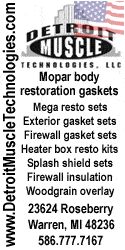What's your idle timing??
Assuming your gas is fresh, and clear; my guess is that,
in order of likelihood;
>your transfer slots are too little exposed underneath the primary throttle-blades. see note 1.
>or your Wet fuel level is too low,
>or your engine vacuum is very low,
>your water temperature is too cold
>or your metering rods are screwed down, way too far,
>or your idle air bleeds are sucking air,
Notes
Note 1, If you don't know it, the transfers are your primary low-speed fuel delivery system. If you dry them up, by either closing the Idle-screw too far, or reducing the Wet fuel level, then the engine stalls when you open the throttle; the mixture screws are just there to enrichen the idle, and should not be open further than about 2.5 turns. If they are, than I can almost guarantee that your transfers are not supplying enough fuel.
Note-2
Your engine can be adjusted to run with any Idle-Timing between about TDC and 25 degrees advanced, so I wouldn't loose sleep if the carb adjustments work best at ~5>8* advance. This is a hint, see note 22.
Note-3
if the intake is a factory cast-iron spread-bore designed for the TQ, make sure the carb base gasket is not leaking along the narrow strip that exists on the Driver's side. When the gasket gets old, it likes to do that; And, if the intake has an EGR valve, make sure it 100% seals at idle. If you have to, remove it and install a gasketed block-off plate. And, If the Secondary throttle plate is not fully closed, fix it! And, finally, check and/or repair the PCV system as may be required. This has tripped up more than a few "shade-tree mechanics".
>>>> the key thing that all these have in common is that besides the PCV, all air entering the engine has to be coming past the transfers.
Note-4
to get the transfer slot exposure about correct;
Put the throttle linkage on the curb-idle screw, and fix it there, then take the carb off, flip it upside down and find the transfer slots. They should appear square to slightly taller than wide, and both the same;
If they are less than square; adjust the curb-idle screw until they are at least square; a lil more is better.
If they are obviously not the same; you will have to fix that but it's usually a lotta work; so if just barely noticeable, I let it slide.
Then flip it right side up, and screw the Mixture screws in to lightly seat them, counting the turns as you go. If they were not the same;
unscrew both of them and inspect the needles. If those are both fine, then flip the carb over again and inspect the idle discharge-ports for integrity. Sometimes they get busted out for whatever reason; IDK.
If the ports and needles are OK, then reinstall them at 2.5 turns out from lightly seated. Then reinstall the carb,
put some fuel in the bowls thru the vent spigot and dribble a bit into the intake, then fire the engine up, but
<<<<DO NOT TOUCH THE SPEEDSCREW.>>>>>
if the Idle speed is too fast, retard the timing.
if the idle speed is too slow, advance the timing.
Your timing window to achieve this should be between TDC and ~10 degrees advanced.
If you cannot achieve a quality idle at these specifications, SOMETHING is wrong, and it's NOT the specs I just gave you. It's gonna be something else, and my first go to is the Wet Fuel level, with a cylinder balance test a close Second.
Note-5
effing ignore the vacuum gauge for now, unless it shows a decided drop every eighth compression cycle, then figure out which one it is, then why, and then fix it!
btw; your engine does not need to idle at max vacuum. Trying to make it so will only lead you down a disappointing road, including a lotta wasted time.
Note-6
The TQ is my all-time favorite carb.
Note-22
here is a shortcut to get you past about 80% of my post.
Since I already know that this combo wants 5 to 10 degrees of Idle timing, just set yours to the low side of that window, start it up, and adjust the speed screw to 650, then reset the mixture screws to 2.5 turns out. Let her warm up to about 180*F.. Then, if she doesn't already work perfect, set your tranfer slot sync, see note 24. With that done, do not touch those screws ever again! lol. Then reset the timing anywhere you want to or need to, that solves all three of these possible issues;
1) elimination of the Tip-in sag and
2) elimination of stalling when going into gear, and
3) elimination of any huge idle drop when going into gear, and
4) reduction of the harshness on the P/N shift, to in-gear.
5) reduction of the engine pulling against the brakes/convertor during a stoplight wait
Obviously, the slower the Idle speed is, the fewer problems you are gonna encounter.
If the Idle-Timing gets outside the window of about 5>10 degrees
to solve all these possible issues,
something else is going on.
DO NOT ADJUST THE CURB IDLE SPEED-Screw,
in an attempt to overcome an unknown issue, Firstly it will upset your sync and secondly after you fix the real problem, you gotta reset the sync again.

As you may have noticed, none of this post depends on a working Vcan. That comes later.
The entire rest of your tune depends on getting this Idle business figured out first, so take your time.
Note-24
at this point, the transfers have to be adjusted to work with the 2.5 turns out mixture screws, as well as is possible. see note 23
So what you do, is screw the mixture screws in or out to get the best quality idle, then add 1/2 turn to prevent the tip-in sag. then see where the screws are.
If less than 2.5 turns out, then the transfers are providing more than necessary, so subtract a lil and repeat. but
If the screws are out more than 2.5, then the transfers are not providing enough, so add a lil transfer fuel, and retest.
Once you got this, you may have to readjust your accelerator-pump to make sure it starts with the lightest pedal tickle., then
go back to Note-22
Note-23
Your carb will work with OTHER base mixture screw settings, besides the 2.5 I have recommended; but here's the deal,
if you run at 3 turns out, the off-idle AFR will go rich, costing you mpgs all the time.
if you run at 2 turns out, the off-idle AFR will go lean, and if you manage to get away from the tip-in sag, it will still cost you mpgs all the time, because you will have to open the throttle more than necessary, to achieve any chosen low-speed circuit speed .
I chose 2.5 turns out, because I believe it will be right for your combo, based on my experience. I could be wrong. see note 25
Note-25
If you want to know the best CRUISE mixture screw setting for any combo, you are gonna have to first know the best CRUISE timing.
Here's what I do;
First I figure out what my cruise rpm will be.
Then I rev it up to there, and keep it there while I advance the timing, bit by bit until additional timing no longer increases the rpm. Then I fix the throttle to keep it at cruise-rpm.
Then on a Holley, I would just adjust the mixture screws to lower the rpm a tad, then give it back; and we're done. But on the TQ I do things in reverse. I first set the mixture screws to 2.25 turns out, usually, then raise or lower the metering rods to see what changes, and find the highest rpm. If the cruise rpm goes up significantly, I reduce the throttle opening and then go back to the metering rods. Of course while I'm doing this, I got one eye on the temp gauge, and if she can't handle that, I gotta fix that before proceeding.
So after I think I got it, I still gotta compensate for the fact that the engine is not under load. So I go back to the mixture screws, and reset them to 2.5, then roadtest it. This may take all summer lol......................

















